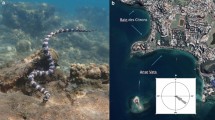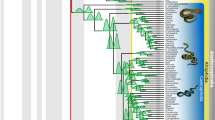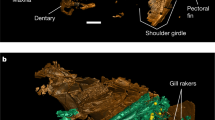Abstract
The largest extant snakes live in the tropics of South America and southeast Asia1,2,3 where high temperatures facilitate the evolution of large body sizes among air-breathing animals whose body temperatures are dependant on ambient environmental temperatures (poikilothermy)4,5. Very little is known about ancient tropical terrestrial ecosystems, limiting our understanding of the evolution of giant snakes and their relationship to climate in the past. Here we describe a boid snake from the oldest known neotropical rainforest fauna from the Cerrejón Formation (58–60 Myr ago) in northeastern Colombia. We estimate a body length of 13 m and a mass of 1,135 kg, making it the largest known snake6,7,8,9. The maximum size of poikilothermic animals at a given temperature is limited by metabolic rate4, and a snake of this size would require a minimum mean annual temperature of 30–34 °C to survive. This estimate is consistent with hypotheses of hot Palaeocene neotropics with high concentrations of atmospheric CO2 based on climate models10. Comparison of palaeotemperature estimates from the equator to those from South American mid-latitudes indicates a relatively steep temperature gradient during the early Palaeogene greenhouse, similar to that of today. Depositional environments and faunal composition of the Cerrejón Formation indicate an anaconda-like ecology for the giant snake, and an earliest Cenozoic origin of neotropical vertebrate faunas.
This is a preview of subscription content, access via your institution
Access options
Subscribe to this journal
Receive 51 print issues and online access
$199.00 per year
only $3.90 per issue
Buy this article
- Purchase on Springer Link
- Instant access to full article PDF
Prices may be subject to local taxes which are calculated during checkout



Similar content being viewed by others
Change history
29 June 2011
Supplementary table 2 has been corrected. Equation 3 has been corrected online in the HTML versions; please see the corresponding Corrigendum.
References
Murphy, J. C. & Henderson, R. W. Tales of Giant Snakes: A Natural History of Anacondas and Pythons (Krieger, 1997)
Rivas, J. The Life History of the Green Anaconda (Eunectes murinus), with Emphasis on its Reproductive Biology. Dissertation, Univ. Tennessee (1999)
Dirksen, L. Anakondas: monographische Revision der Gattung Eunectes Wagler 1830 (Serpentes, Boidae) (Natur und Tier, 2002)
Makarieva, A. M., Gorshkov, V. G. & Li, B.-L. Gigantism, temperature and metabolic rate in terrestrial poikilotherms. Proc. R. Soc. Lond. B 272, 2325–2328 (2005)
Makarieva, A. M., Gorshkov, V. G. & Li, B.-L. Temperature-associated upper limits to body size in terrestrial poikilotherms. Oikos 111, 425–436 (2005)
Rage, J.-C. Palaeophis colossaeus nov. sp. (le plus grand Serpent connu?) de l’Eocène du Mali et le problème du genre chez les Palaeopheinae. C.R. Acad. Sci. Sér. 2, 1741–1744 (1983)
Albino, A. M. Serpientes gigantes en la Patagonia. Ciencia Hoy 3, 58–63 (1991)
Scanlon, J. D. & Mackness, B. S. A new giant python from the Pliocene Bluff Downs local fauna of northeastern Queensland. Alcheringa 25, 425–437 (2002)
Head, J. J. & Polly, P. D. They might be giants: morphometric methods for reconstructing body size for the World’s largest snakes. J. Vertebr. Paleontol. 24 (suppl. 3). 68A (2004)
Sloan, L. C. & Shellito, L. J. in Causes and Consequences of Globally Warm Climates in the Early Paleogene (eds Wing, S. L., Gingerich, P. D., Schmitz, B. & Thomas, E.) 25–47 (Geological Society of America Special Paper, 369, 2003)
Jaramillo, C. et al. Palynology of the upper Paleocene Cerrejón Formation, Northern Colombia. Palynology 31, 153–189 (2007)
Scanlon, J. D. Skull of the large non-macrostomatan snake Yurlunggur from the Australian Oligo–Miocene. Nature 439, 839–842 (2006)
Head, J. J. & Polly, P. D. Dissociation of somatic maturity from segmentation drives gigantism in snakes. Biol. Lett. 3, 296–298 (2007)
Polly, P. D. & Head, J. J. in Morphometrics-Applications in Biology and Paleontology (ed. Elewa, A. M. T.) 197–222 (Springer, 2004)
Alexander, G. J. in Biology of the Boas and Pythons (eds Henderson, R. W. & Powell, R.) 51–75 (Eagle Mountain Publishing, 2007)
Shine, R., Harlow, P. S., Keogh, J. S. & Boeadi The influence of sex and body size on food habits of a giant tropical snake, Python reticulatus . Funct. Ecol. 12, 248–258 (1998)
Alroy, J. Cope’s rule and the dynamics of body mass evolution in North American fossil mammals. Science 280, 731–734 (1998)
Shellito, C. J., Sloan, L. C. & Huber, M. Climate model sensitivity to atmospheric CO2 levels in the Early–Middle Paleogene. Palaeogeogr. Palaeclimatol. Palaeoecol. 193, 113–123 (2003)
Pearson, P. N. et al. Stable warm tropical climate through the Eocene epoch. Geology 35, 211–214 (2007)
Herrera, F., Wing, S. & Jaramillo, C. Warm (not hot) tropics during the Late Paleocene. First Continental Evidence. Eos Trans. AGU 86 (Suppl.). PP51C–0608 (2005)
Kowalski, E. A. & Dilcher, D. L. Warmer paleotemperatures for terrestrial ecosystems. Proc. Natl Acad. Sci. USA 100, 167–170 (2003)
Burnham, R. J. & Johnson, K. R. South American paleobotany and the origins of neotropical rainforests. Phil. Trans. R. Soc. Lond. B 359, 1595–1610 (2004)
Hogan, K. P., Smith, A. P. & Ziska, L. H. Potential effects of elevated CO2 and changes in temperature on tropical plants. Plant Cell Environ. 14, 763–778 (1991)
Iglesias, A. et al. A Paleocene lowland macroflora from Patagonia reveals significantly greater richness than North American analogs. Geology 35, 947–950 (2007)
Crowley, T. J. & Zachos, J. C. in Warm Climates in Earth History (eds Huber, B. T., MacLeod, K. G. & Wing, S. L.) 50–76 (Cambridge Univ. Press, 2000)
Huber, M. A hotter greenhouse? Science 321, 353–354 (2008)
Chappell, M. A. & Ellis, T. M. Resting metabolic rates in boid snakes: allometric relationships and temperature effects. J. Comp. Physiol. B 157, 227–235 (1987)
Vidal, N. & Hedges, S. B. Higher-level relationships of snakes inferred from four nuclear and mitochondrial genes. C.R. Biol. 325, 977–985 (2002)
Lawson, R., Slowinski, J. B. & Burbrink, F. T. A molecular approach to discerning the phylogenetic placement of the enigmatic snake Xenophidion schaeferi among the Alethinophidia. J. Zool. (Lond.) 263, 285–294 (2004)
Vidal, N. et al. The phylogeny and classification of caenophidian snakes inferred from seven nuclear protein-coding genes. C.R. Biol. 330, 182–187 (2007)
Acknowledgements
We thank C. Bell, R. Ghent, E. Kowalski, A. M. Lawing, B. MacFadden, R. Reisz and S. Wing for advice and discussion, K. Seymour, K. Krysko, K. deQueiroz and G. Zug for access to comparative specimens, A. Rincon and M. Carvalho for fieldwork, J. Mason, K. Church, J. Mathis and J. Nestler for fossil preparation, and K. Krysko and J. Nestler for photographic assistance. We thank Carbones del Cerrejón, L. Teicher, F. Chavez, C. Montes and G. Hernandez for logistical support and access to the Cerrejón mine. This research was funded by the National Science Foundation, Fondo para Investigaciones del Banco de la Republica de Colombia, Smithsonian Tropical Research Institute Paleobiology Fund, the Florida Museum of Natural History, a Geological Society of America Graduate Student Research Grant to A.K.H., and a National Sciences and Engineering Research Council of Canada Discovery Grant to J.J.H.
Author Contributions J.J.H., J.I.B., C.A.J., P.D.P., A.K.H. and J.R.B. contributed to project planning. J.J.H. and J.I.B. contributed to systematic palaeontology. J.J.H., P.D.P., J.I.B., A.K.H., J.R.B. and E.A.C. contributed to body size estimation. J.J.H., J.I.B., F.A.H., P.D.P. and C.A.J. contributed to palaeoclimatic analysis. J.I.B., A.K.H., E.A.C., F.A.H. and C.A.J. contributed to fieldwork. J.I.B., A.K.H., C.A.J. and J.J.H. contributed to financial support. All authors contributed to manuscript and figure preparation.
Author information
Authors and Affiliations
Corresponding author
Supplementary information
Supplementary Information
This file contains Supplementary Figures 1-4 with Legends, Supplementary Data and Supplementary Tables 1-3. Supplementary table 2 has been corrected since its original online publication. (PDF 640 kb)
Rights and permissions
About this article
Cite this article
Head, J., Bloch, J., Hastings, A. et al. Giant boid snake from the Palaeocene neotropics reveals hotter past equatorial temperatures. Nature 457, 715–717 (2009). https://doi.org/10.1038/nature07671
Received:
Accepted:
Issue Date:
DOI: https://doi.org/10.1038/nature07671
This article is cited by
-
High morphological disparity in a bizarre Paleocene fauna of predatory freshwater reptiles
BMC Ecology and Evolution (2022)
-
The multicausal twilight of South American native mammalian predators (Metatheria, Sparassodonta)
Scientific Reports (2022)
-
Evolution and dispersal of snakes across the Cretaceous-Paleogene mass extinction
Nature Communications (2021)
-
Paleogene Land Mammal Faunas of South America; a Response to Global Climatic Changes and Indigenous Floral Diversity
Journal of Mammalian Evolution (2014)
-
A universal scaling relationship between body mass and proximal limb bone dimensions in quadrupedal terrestrial tetrapods
BMC Biology (2012)
Comments
By submitting a comment you agree to abide by our Terms and Community Guidelines. If you find something abusive or that does not comply with our terms or guidelines please flag it as inappropriate.



